What Is Waltonchain?
Waltonchain (or WTC for short) is a genuine, trustworthy and traceable business ecosystem with complete data sharing and absolute information transparency. It is created through a combination of the RFID and blockchain technologies, which pushes forward the blockchain + the Internet of Things integration.
Bitcoin appeared in 2009 and began to circulate. The total market capitalization of Bitcoin has exceeded $ 30 billion, making Bitcoin a successful application of the blockchain technology in the field of digital money. Ethereum introduced smart contracts to program the complex contract rules into the blockchain by way of code.
Smart contracts can be automatically executed when the agreed conditions are reached, as a result, the field of application of the blockchain has been broadened; the representative Namecoin and Datacoin extended the object of the blockchain from the electronic money trading record in the era of Bitcoin to the domain name, user data and other fields.
- Overview - Table of Contents
- What Is Waltonchain?
- Getting Started With Waltonchain
- How To Get A Waltonchain Wallet?
- Waltonchain Resources
- How To Buy Waltonchain?
- How To Earn Waltonchain?
- What Is Waltonchain Mining?
- Latest Waltonchain News
As an organic component of the blockchain distributed implementation, the consensus mechanism has also undergone full development; as a result, several major consensus mechanisms have appeared: POW: Proof of Work, e.g. Work to Prove Consensus Mechanism, also known as the mining mechanism. Bitcoin is first one to use the POW mechanism to dominate the block generation.
The node continues trying to calculate the block hash value corresponding to each block ledger’s content to satisfy a specific condition, that is, N zeros are used as the preamble. This will increase the difficulty of Block generation, significantly reducing the risk of correct subchains being replaced by quickly generated longer malicious subchains, but will also lead to the waste of many computing resources of the mining machines at the same time. POS: Proof of Stake, e.g. Stake to Prove Consensus Mechanism.
It is an upgrade of the POW consensus mechanism to control the length of mining time based on the number of the tokens and the holding time of the node; it can effectively reduce the mining time, but still cannot avoid the problem of wasting the computing resources of the mining machines. DPOS: Delegated Proof of Stake, e.g. Delegated Stake to Prove Consensus Mechanism.
Its principle is that tokens select a certain number of nodes by voting to complete the verification and accounting work for them. This consensus mechanism can greatly reduce the number of nodes involved in accounting and verification to achieve rapid consensus verification, but it also relies on the existence of the tokens, so that some applications that do not require tokens will be limited.
PBFT: Practical Byzantine Fault Tolerance. It is a consistency algorithm by message transmission that achieves consistency through three phases to determine the final block generation. If there are 3f + 1 nodes, this algorithm can tolerate the existence of f error nodes, so that the consistency results will not be 5 affected.
This mechanism can be divorced from the existence of coins, the consensus node can be determined by participants and regulators, and 2—5 seconds of shared delay are basically able to meet the commercial requirements. Various consensus mechanisms have their own considerations and significance in terms of their respective business scenarios and technical means.
When compared to each other, they have different improvements and enhancements in different aspects, as well as different disadvantages, so there seems to be no optimal consensus mechanism. Achieving the pluggable applications of various consensus mechanisms, choosing the right consensus mechanism according to the specific application scenario and optimizing the application of blockchain shall be the best way for further application in more fields.
Various trends indicate that blockchain technology is expanding its application to more and more areas, such as digital money and smart contracts, while the earlier relevant technologies failed to break the connection barrier between the virtual network and the real world.
Applying the blockchain to the Internet of Things and smart systems and connecting the item tags and identity tags in the real world to the virtual network via RFID technology will successfully build this connection, ultimately achieve the interconnection of all things and create the era of Value Internet of Things (VIoT).
Traditional Internet of Things (IoT) is a network which enables all the common objects that can perform independent functions to be interconnected. It connects the sensors, controllers and objective entities through network technology to realize intelligent management and control.
For example, through radio frequency 6 identification (RFID), infrared sensors, global positioning systems, laser scanners and other information sensing equipment, it connects any item to the Internet to carry out information exchange and communication according to the agreement, to achieve intelligent identification, positioning, tracking, monitoring and management.
- Overview - Table of Contents
- What Is Waltonchain?
- Getting Started With Waltonchain
- How To Get A Waltonchain Wallet?
- Waltonchain Resources
- How To Buy Waltonchain?
- How To Earn Waltonchain?
- What Is Waltonchain Mining?
- Latest Waltonchain News
As an extension of the Internet, the Internet of Things further promotes the connections between machine and machine, human and machine and achieves the full life cycle circulation management of data in the information world. With the continuous advances of technology, the development and application of the Internet of Things technology have achieved remarkable results in recent years.
There are already billions of sensors and smart controllers put into use so far, and the number of the sensors and smart controllers is expected to grow in the next few years. However, the Internet of Things technology is also facing many problems and challenges which may become great obstacles for the future development and application of the Internet of Things.
The era of the Value Internet of Things led by RFID and blockchain technologies can provide solutions to these problems. The technical realization of the Value Internet of Things means connecting the items tags, event tags, people and body tags and other entity tags in the real world with the virtual world of the Internet through the underlying hardware platform using the RFID tags as the core, combined with the blockchain technology delivering value and constructing trust, to achieve the real interconnection of all things.
The speed of transition from the Information Internet and traditional Internet of Things to the Value Internet of Things based on RFID and blockchain technology may be far beyond the current expectations. When the Value Internet of Things 7 achieves the real interconnection of all things, the RFID and blockchain technology will play a greater role.
The whole system of the Value Internet of Things can be divided into two parts: hardware and software. The hardware includes the RFID tag chips and the RFID reader chips.
The RFID tag acts as the interface for all assets to be connected to the chain, and the reader chip is a bridge for all assets to be connected to the chain and can be used as a node on the chain. The software includes the Waltonchain software system, the Waltonchain protocol and Waltoncoin. With the combination of software and hardware, the Value Internet of Things can really achieve the connection of all things to the chain and the digitalization of all assets.
What is RFID?
The Radio Frequency Identification (RFID) technology is a communication technology that can identify specific targets and read and write relevant data through the radio signals without building a mechanical or optical contact between the recognition system and specific targets. RFID readers are divided into mobile readers and fixed readers.
At present, RFID technology is widely used, for example, in library access control systems, for food safety traceability, etc. The radio frequency tags are the physical carrier of the electronic product code (EPC) which are attached to traceable items, identifiable, readable and writeable and can be circulated all over the world. As a key technology for constructing the "Internet of Things", the RFID technology has received attention 9 in recent years.
The RFID technology originated from the United Kingdom, it was used in the Second World War to identify friend or foe aircraft. Its business application began in the 1960s. The RFID technology is an automatic identification technology. The US Department of Defense states that all military supplies must use RFID tags since January 1, 2005, and the US Food and Drug Administration (FDA) recommends that the pharmaceutical companies use RFID to trace drugs easy to be faked since 2006.
By using the RFID technology, Walmart and Metro retailers have further promoted the application of RFID in the world. In 2000, the price of each RFID tag was $1. Many researchers believed that RFID tags were very expensive, large-scale application could be realized only when the price went down. In 2005, the price of each RFID tag was about 12 cents, and now the price of each UHF RFID tag is about 10 cents.
To achieve large-scale application of RFID, on the one hand, it is necessary to reduce the price of RFID tags, on the other hand, it depends on whether the application of RFID can bring value-added services. Eurostat statistics show that in 2010, 3% of the EU companies used RFID technology for identity documents and access control, supply chain and inventory tracking, car charges, security, production control and asset management, etc.
Since 2010, due to the improvement of economic situation, the development of the Internet of Things industry and other positive factors, global RFID market continues to heat up, RFID technology has been applied to a growing number of fields, and people have had higher expectations for the development of RFID industry. The RFID technology is in a period of rapid maturity, many countries are actively promoting RFID as an important industry.
Although the prices of passive UHF electronic tags fell rapidly in the past two years, the prices of UHF RFID systems are still high relative to the overall cost of RFID chips, including readers, electronic tags, middleware, system maintenance, etc. And the cost of UHF RFID system is an important indicator for clients to 10 estimate the return of investment.
The bottleneck caused by high cost has become an important factor restricting the development of UHF system market. In short, the passive UHF market is still in its early stage of development. Thus, the core technology needs breakthroughs, business models need to be innovated and improved, and the industry value chain needs to be further developed and extended. Only when the core issues are effectively resolved, can we embrace the real development of RFID passive UHF market.
The Waltonchain ecosystem uses an overall structure including a parent chain and subchains (or child chains) where the parent chain is Waltonchain and the token used for circulation and payment is called Waltoncoin. During the 1.0 stage of the project, the parent chain — Waltonchain — is used to open up a complete supply chain system of the apparel industry, including production, logistics, warehousing and stores.
Theoretically, there can be an infinite number of subchains. For example, recognizers of a production workshop used to monitor product quality can be used as nodes of a production subchain, and the production workshops of a variety of brands together constitute the production subchain. For 19 another example, stores of a variety of apparel brands can constitute a sales subchain.
Waltonchain Bottom Layer - The bottom layer is developed based on Waltonchain. Waltonchain has many advantages, please see the introduction of Waltonchain for details.
Waltonchain Core Layer - Waltonchain is developed based on the universal blockchain technology. To meet common and individual requirements of different applications, the core layer will include common and personalized features as a package to form core modules of different applications.
Waltonchain Middle Layer - For different applications, Waltonchain has dedicated and common interfaces to call for the application layer. The middle layer is used to achieve the package of these interfaces, thus simplifying the work of the application layer and reducing the application difficulty.
Waltonchain Application Layer - As for the top-layer content, users or the Waltonchain team can develop an appropriate platform or environment based on different application scenarios to meet individual, team or business needs of an application.
The detailed structure of Waltonchain
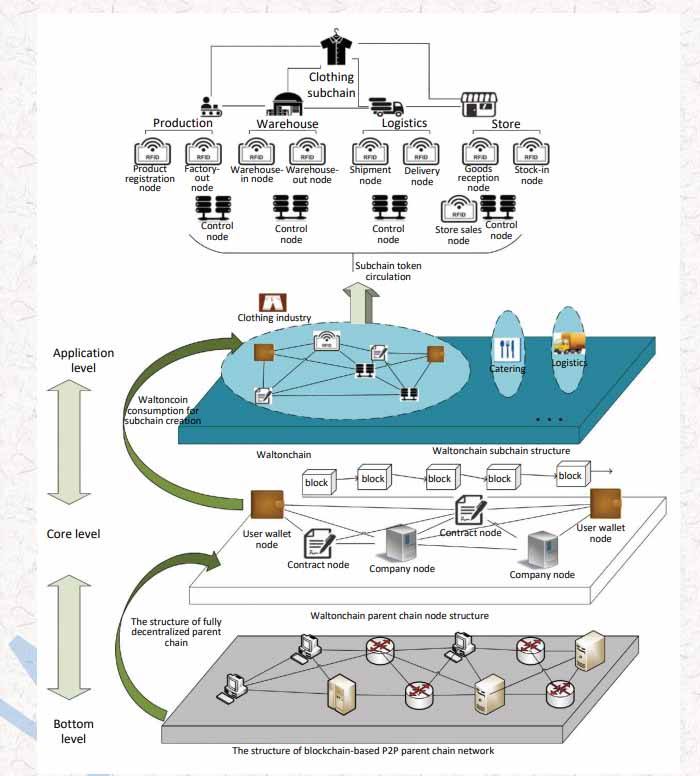
Waltonchain Parent Chain
The Waltonchain parent chain is the main chain of the Waltonchain blockchain, starting from the Waltonchain Genesis Block, which provides a wealth of functions including but not limited to Waltoncoin (WTC) transaction management, subchain management, smart contract, alias and account control, etc.
1) transaction management - A total of 100 million of WTCs are issued, created in the genesis block and assigned to each account in accordance with established program. The total amount of WTCs in the subsequent transactions remains the same. Through the decentralized network, more accounts will be created through the nodes, and a lot of WTC transactions will also be carried out between the accounts.
- Overview - Table of Contents
- What Is Waltonchain?
- Getting Started With Waltonchain
- How To Get A Waltonchain Wallet?
- Waltonchain Resources
- How To Buy Waltonchain?
- How To Earn Waltonchain?
- What Is Waltonchain Mining?
- Latest Waltonchain News
Every 60 seconds, all the transactions during the current period will be recorded to a block, linked to the previous block, forming the Waltonchain parent chain. The parent chain is the public ledger of WTC transactions stored dispersedly in nodes in the network to ensure safety and reliability of transaction data.
2) subchain management - Another major function of Waltonchain parent chain is the management of subchain which can be created by any account at any time after the parent chain runs. The creator can customize the detail functions of the subchain and specific information of the subchain tokens.
This custom information forms the data structure describing the subchain, which is recorded in the block of the current period by the accounting nodes in a way similar to the WTC transaction record. So far this subchain will be used as a separate blockchain, recording the transactions of the subchain tokens.
Since the WTC transactions are only recorded in the parent chain, the parent chain runs independently of the subchain. The nodes running on the parent chain only need to save the parent chain data to conduct consensus and validation of WTC transaction blocks.
This flexible creation mechanism of WTC subchain makes subchains scalable, the state of subchains has no effect on the completeness and safety of the parent chain; except for recording the subchain description information, the number of subchains will not increase the size of the parent chain.
3) smart contract - In the system architecture of the Waltonchain blockchain, the smart contract based on its programmable features is responsible for building the underlying logic platform and supporting the operation of the upper architecture layers, namely the core layer, the middle layer and the application layer. It is the cornerstone of Waltonchain, which enables it to develop a wider range of custom applications.
Smart contract technology is developed by Ethereum and has been applied in the electronic token release, electronic crowdfunding, electronic contracts, electronic equity distribution and other fields. The Waltonchain blockchain technology defines two types of account concepts: one is the general account storing the tokens; the other is the smart contract account storing smart contract procedures.
When a transaction is sent to the smart contract account address, the corresponding smart contract procedure will be triggered and implemented. The procedure will use the data of the received transaction, the data stored in this account and the current block status data as input data, will perform the customized operations, make transaction requests, modify the account status data and execute other result behaviors.
4) other functions - Decentralized asset transactions: supporting the decentralized asset transactions of the parent chain WTCs and subchain coins; Decentralized grading system: grading according to the performance of the account nodes’ trading behaviors such as mortgage; Decentralized alias system: facilitating the realization of the transactions by alias; Account control; Voting system; Cross currency transactions;
Waltonchain Subchain
1) subchain functional features - During its creation, a subchain can be customized to support all the functional features of the parent chain, or can be limited to certain functional features to achieve the customization of the appropriate features.
The supported custom features mainly include subchain token transactions, subchain token and parent chain token transactions, cross subchain token transactions, smart contracts, aliases, voting system, account control, instant messaging and data storage.
2) subchain token transactions - By customization, the subchain can support subchain native token transactions, subchain token and parent chain token transactions and cross subchain token transactions. When a cross token transaction is made, the holder of the token makes a transaction request, the transaction request information contains the transaction type (buy or sell), the local token type, the target token 25 type, transaction price and the number of transaction tokens.
Then the Waltonchain protocol will match the buy and sell transactions in a decentralized way, which is open, fair, reliable and traceable compared to the traditional trading centers.
Block Structure
The trading ledgers of WTCs are stored in the Waltonchain blocks that are series connected, forming the Waltonchain parent chain and subchains. These blockchains are stored in many nodes on the Waltonchain network, making the WTC transaction records open, safe, decentralized, traceable and tamper-resistant.
The core component of this ambitious, secure and decentralized data structure is the block data structure designed by the Waltonchain team. It provides the parent chain with the features of safe, stable and fast response and provides subchains with a flexible combination of features, so as to adapt to a variety of Internet of Things applications and to match customized business models.
A Waltonchain block can contain up to 255 transaction records. Each transaction record contains a header carrying the identification information. The general information contained in the block is as follows:
- Block depth and timestamp
- Block identity
- Block account ID and public key
- The identity of the previous block and the hash value
- The total number of tokens of the transactions contained in the block and byte fee
- The transaction information contained in the block
- Block payload length and payload hash value
- The generated signature of the block
- Accumulated coinage difficulty of the block
Getting Started With Waltonchain
Value Internet of Things (VIoT) constructs a perfect commercial ecosystem via the integration of the real world and the blockchain.Ushering human beings into the reliable digital life.Waltonchain unfolds the new era of Value Internet of Things (VIoT).
- Wisdom
- Alter
- Label
- Trade
- Organization
- Network
The Logic of Waltonchain Appreciation
- Any child chain creation needs to expend Walton Coins (WTC). As the Walton ecosystem continues to grow, an increasing number of businesses will be joining the ecosystem, as a result of which they will expend a growing amount of WTC to create all kinds of child chains. Thus, the demands for WTC will rise correspondingly.
- WTC is the only token of the parent chain in the entire business ecosystem. Any cross-child-chain ata transmission and asset exchange will expend WTC. Once the ecosystem has been in place, the demands from the businesses for WTC will keep expanding.
- The allocation mechanism of the transaction fees (such as A coins and B coins ) expended in the important officially-released child chains will be adjusted in an innovative manner, such as those in the transaction child chain or the sales child chain which will be used in the high-frequency circulation. Most of the transaction fees (say 90%) will be allocated to the wallets of child chain book-keeping nodes, while a small proportion (say 10%) will be exchanged to WTC and allocated to the wallets of parent chain book-keeping nodes.
The Project
The realization of Value Internet of Things will create a brand new business ecosystem, based on organic integration of blockchain and Internet of Things. This will extend the blockchain technology from Internet to Internet of Things, which will in turn create a genuine, believable, traceable business model with totally shared data and transparent information, depending on the combination of RFID technology and Waltonchain.
Waltonchain team has formulated a 4-phase development plan, starting from infrastructure platform establishment to gradually incorporating retail, logistics and product manufacturing, and to finally achieving the full coverage of business ecosystem.
Value of Waltoncoin
1. It can be used as a currency to purchase related commodities;
2. It can be used as a credit measurement unit on the Internet of Things;
3. It can be used as a workload or quality measurement unit on the Internet of Things;
4. It can be used as a value storage or value transfer medium;
5. It enjoys high popularity and increasing demand, while the emission is fixed; thus, the potential of its appreciation is tremendous.
Compared with traditional RFID tag chips, the RFID tag chip designed in the project has the following advantages:
1. An asymmetric encryption and decryption module is integrated into the tag chip of this project, bringing out safer tag communication;
2. A dedicated storage space is integrated into the tag chip of this project to store the hash value of tag status and key information, which makes the tag content truly tamper-resistant;
3. The tag chip of this project adopts the low voltage and low power consumption design and applies advanced technologies; on a bigger scale, its power consumption is lower than that of traditional design;
4. The anti-collision logic is added to the design scheme of the tag chip of this project. As a result, the collision probability is lower, and the probability of record skipping during reading is reduced significantly.
How To Get A Waltonchain Wallet?
Wallet Usage Notice
1. The WTC Wallet is part of the Waltonchain Parent Chain System. Please do not transfer the ERC 20 WTC Token on the Ethereum directly to the WTC Wallet to avoid any loss of assets.
2. Please do not transfer WTCT from WTC Wallet to any Ethereum Wallets and Ethereum based ERC 20 WTC Token addresses on trading platforms to avoid any loss of assets before the official token swap.
Create Wallet
Send
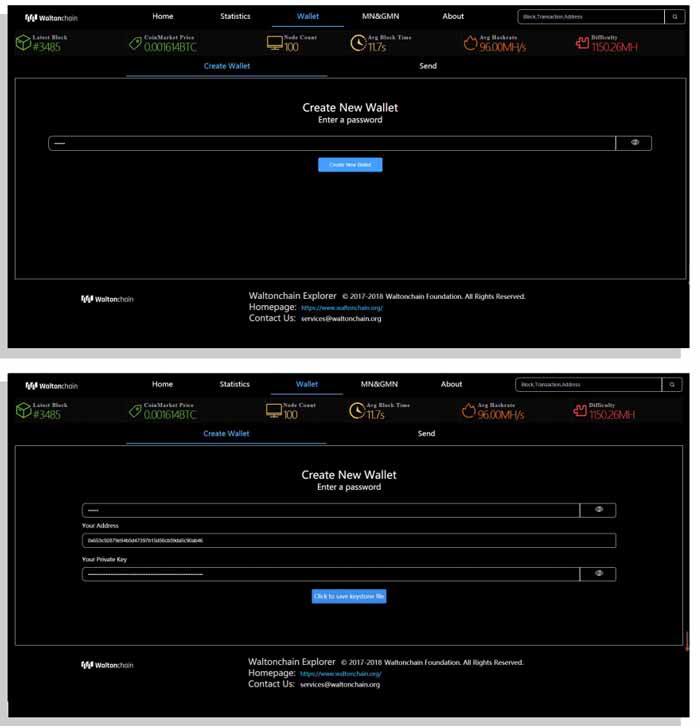
- Enter your wallet passphrase, then click "Create New Wallet"
- A new wallet public address, and the corresponding private Key are generated. Please copy and save the private key, and click "Download" to download the wallet's Keystore / JSON file and keep it safe. Both of them can be used to open the existing wallet.
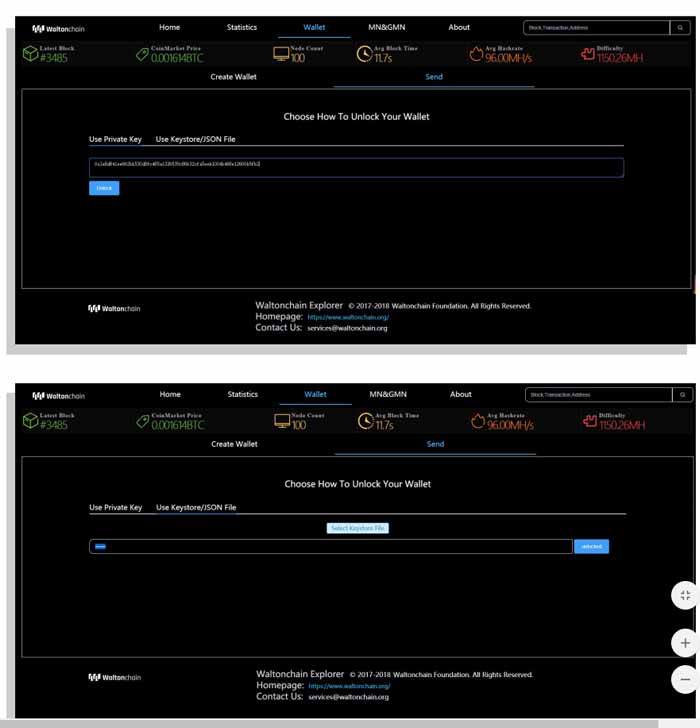
- Unlock Your Wallet You can open the wallet in the following two ways:
A . With Your Private Key Paste the private key generated during the wallet creation, click “Unlock” to unlock the wallet.
B . Use Keystore/JSON file to unlock the Wallet Click “Select Keystore File” to upload the Keystore/JSON file that was downloaded after the wallet creation, and enter your passphrase. Click “Unlock” to unlock the wallet.
- Both above methods lead to the wallet’s Send page. On this page you can send WTC and view wallet information including wallet balance.
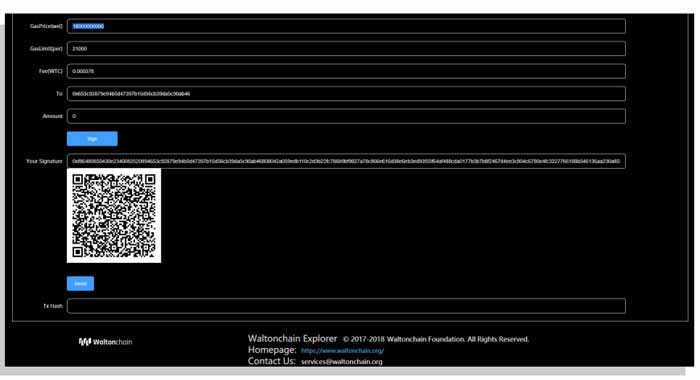
A . Set Gas Price and Gas Limit, the higher the Gas Price, the faster the transaction speed; the default Gas value is recommended;
B . Enter the recipient's WTC address in the field “To”;
C . Enter the transaction amount in the field “Amount”;
D . Click “Sign” to generate a signature containing the transaction information;
E . Click “Send”, confirm the transaction and get the Tx Hash for this transaction.
Waltonchain Resources
How To Buy Waltonchain?
You are not able to purchase WTC with “Fiat” currency so you will need to first purchase another currency – the easiest to buy are Bitcoin or Ethereum which you can do at Coinbase using a bank transfer or debit / credit card purchase and then swap that for WTC at an exchange such as Binance.
Register at Coinbase
For first time buyers of crypto currency, we recommend that you use Coinbase to make your first purchase – its easy to use, fully regulated by the US government so you know it is one of the safest and most reputable places to purchase cryptocurrency from. Coinbase offers the ability to purchase Bitcoin, Litecoin and Ethereum with a credit or debit card or by sending a bank transfer. The fees are higher for cards but you will receive your currency instantly.
- Overview - Table of Contents
- What Is Waltonchain?
- Getting Started With Waltonchain
- How To Get A Waltonchain Wallet?
- Waltonchain Resources
- How To Buy Waltonchain?
- How To Earn Waltonchain?
- What Is Waltonchain Mining?
- Latest Waltonchain News
You will have to carry out some identity verification when signing up as they have to adhere to strict financial guidelines. Make sure you use our link to signup you will be credited with $10 in free bitcoin when you make your first purchase of $100.
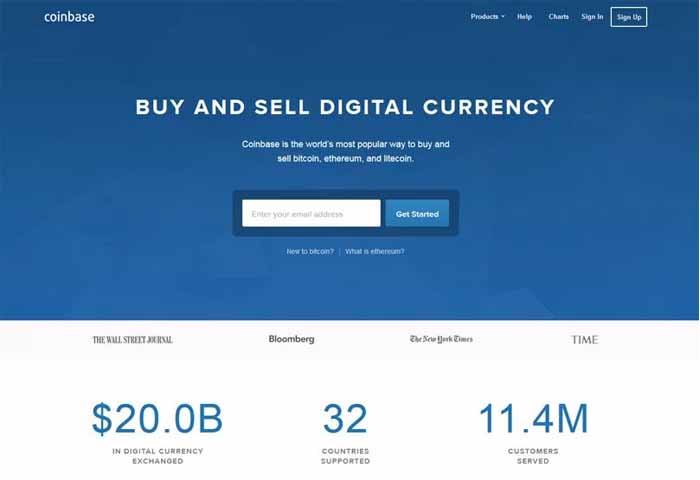
To get started, click the “Sign up” button where you will be taken to a registration form where you will need to enter your name, email and choose a password.
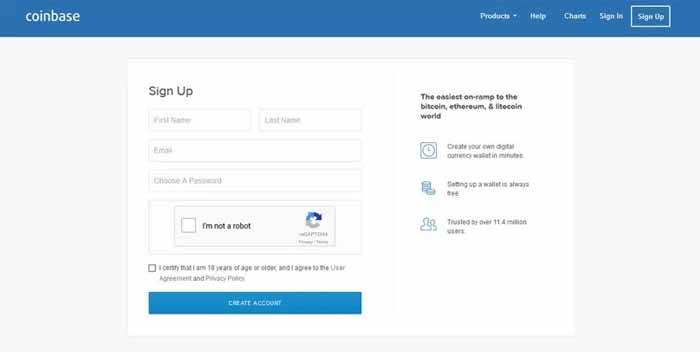
Coinbase will then send you a link via email to verify your email account, once you click the link in the email you will be taken to a verification page. You must then add your phone number and upload a photo of your ID – this can be a passport, driving license etc. You also have to add your payment details, so you can add your bank account or a debit or credit card as required – after a short period your account will then be verified and you can then make your first purchase.
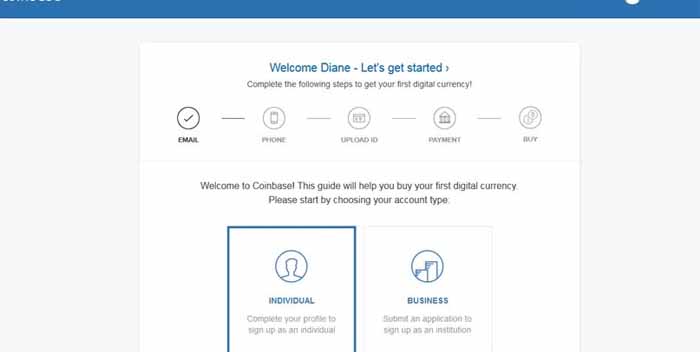
Purchase Ethereum or Bitcoin
For this guide, we will be purchasing Ethereum to swap for our target cryptocurrency. The reason for this is that it has far cheaper fees than bitcoin for sending and the transaction also happens a lot faster. So in Coinbase, visit the “Buy / Sell” tab at the top, select “Ethereum”, choose your payment method and enter the amount you wish to purchase – you can either enter a US Dollar amount or a number of Ether.
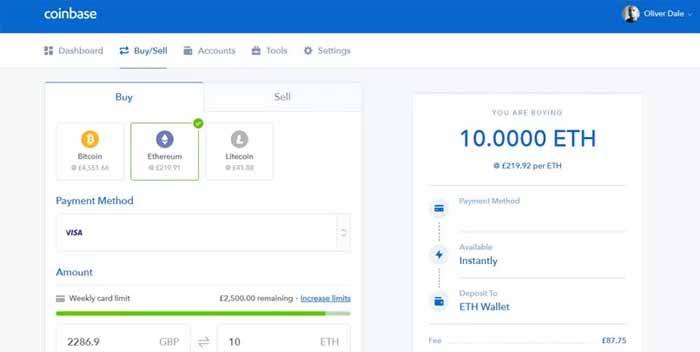
You will then be asked to confirm your transaction, if paying with a card you might have to complete a verification with your card provider. Once that’s complete, your Ethererum will be added to your account.
Purchase WTC at Binance
You can now send your Ether over to Binance to make your purchase of WTC, take a look at our review of Binance here to see how to signup and purchase on their exchange.
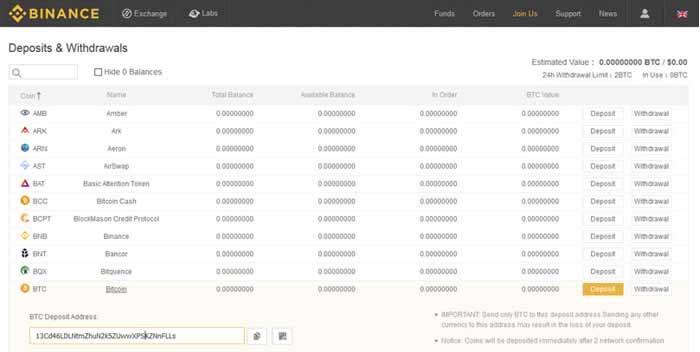
Once you have purchased your Walton Chain tokens, we recommend you withdraw them to your Ethereum wallet rather than leaving them on the exchange.
What Is Waltonchain Mining?
The Walton team intend to develop the Waltonchain in four growth stages staring from building the underlying foundation, gradually extending to retail, logistics networks and finally integrating product manufacturers.
As discussed above, at phase 1.0 of the project, the Waltonchain team have developed a clothing system integration solution based on RFID technology which has been applied to several pilot projects. The next step is the development of RFID chips which use an asymmetric encryption algorithm that will be used with the Walton network.
During phase 2.0 of the project, the RFID chips will be in mass production to be used in the retail and logistics industry. It will include a smart credit system, allowing customers to pay for, manage, evaluate, trace and trade products throughout the supply chain. During phase 2.0 the developers anticipate that the logistics industry will be able to achieve full path logistics information on the chain, covering the complete logistics process from warehouse to customer.
During phase 3.0 of the project, the technology will be applied to the manufacturing stage to achieve traceable customization of smart packaging. This phase will include all of the phases of the production chain, including the purchase of raw materials, production and assembly, and packaging. The intention is that this will eliminate the possibility of counterfeiting.
1.1 SOFTWARE CONFIGURATION
1.2 DISABLE WDDR
1.3 LOGIN THE WALTONCHAIN FULL-NODE WALLET AND CLICK “MINING”
1.4 CLICK THE GPU BUTTON, ENTER THE RECEIVE WALLET ADDRESS AND CLICK “START MINING”
1.5 OPEN THE WINDOWS TASK MANAGER AND YOU CAN CHECK THE UTILIZATION OF GPU
1.6 YOU HAVE STARTED GPU MINING
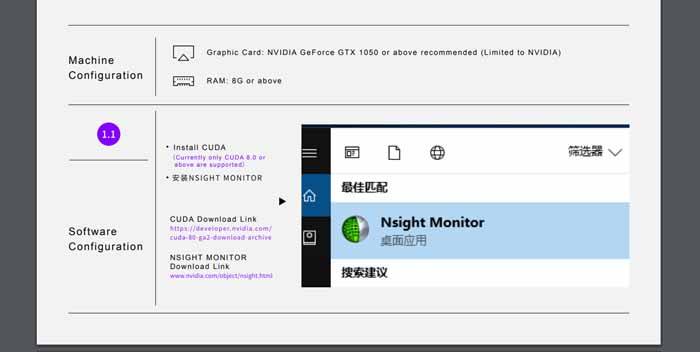
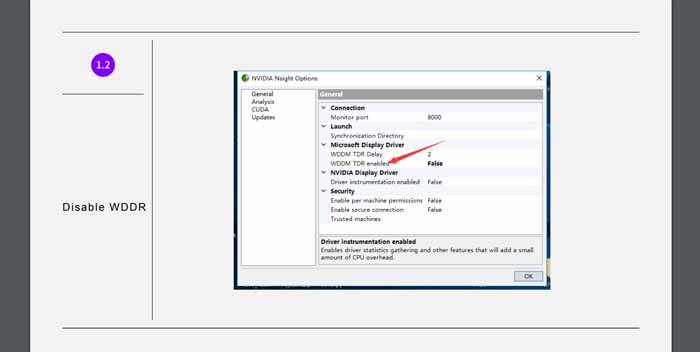
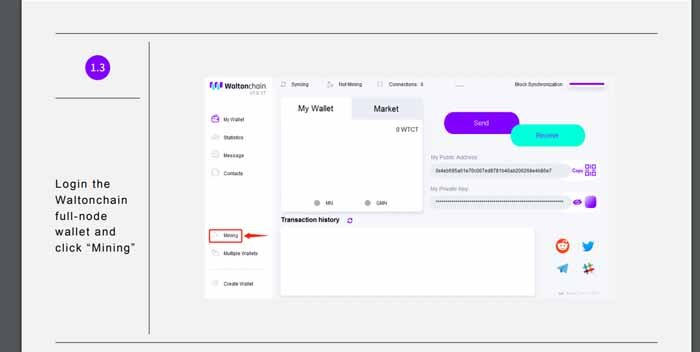
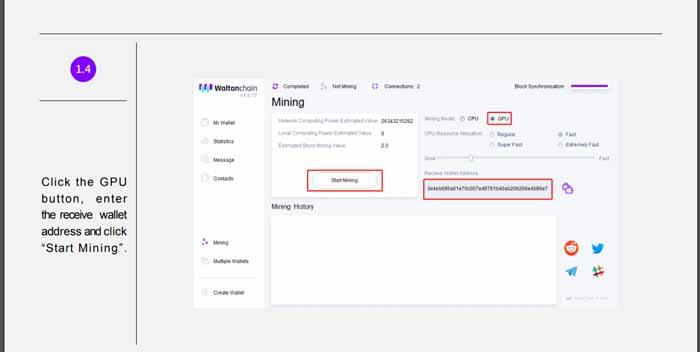
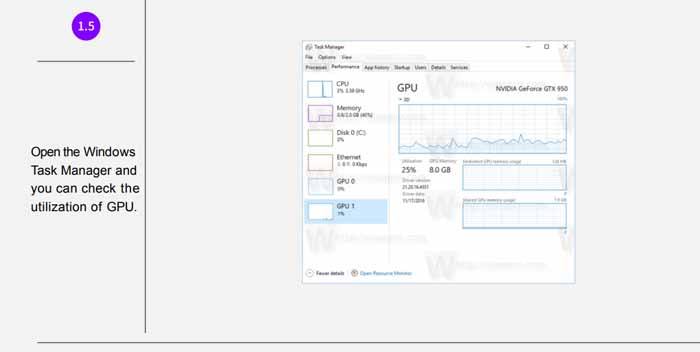
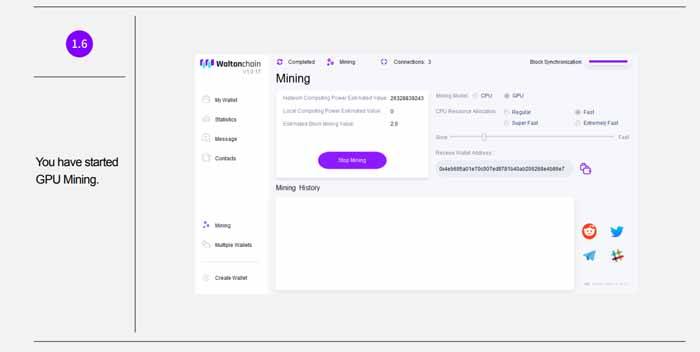
Latest Waltonchain News
Waltonchain Mainnet Launch Announcement
Dear Waltonchain supporters and WTC holders, We are excited to announce that today, March 31st 2018, Waltonchain Mainnet will be launched! Waltonchain is an innovative blockchain platform where users can call smart contract functions in the form of transactions through ABI and contract addresses. As a public ledger where WTC circulates, the Waltonchain Mainnet stored in a distributed way in all nodes across the network ensures the safety and reliability of transaction data.
Our Mainnet features customized scaling design which enables creation of child chains, communication and data transfer between different industries, and utilizes the cross-chain protocol for data interoperability. When the Waltonchain goes live, eventually all respective critical data created during the operation of our child chains, such as inventory, production, logistics etc., will be uploaded to the blockchain.
As a means for data uploading to the chain, data circulation and consumption validation on the chain, WTC promotes the cross-industry data flow and value circulation. It serves as a foundation for DApps development, data analysis and market forecast, and therefore helps solve the problems of inaccurate customer targeting and analysis.
The Waltonchain Mainnet has the following features:
1. Compatibility with the underlying Ethereum technology, provides the ability to hold more data from different industries and the integration basis for various child chains and ensures reliability and safety;
2. Adoption of the PoW+PoS consensus mechanism improves fairness and efficiency;
3. The improved hash algorithm to achieve greater safety and avoid node computation dominance;
4. Support of WTC transactions on the Mainnet;
5. The improved mining reward strategy which takes into account the number of WTC and holders loyalty.
With the Mainnet launch, Waltonchain also releases the:
• Waltonchain Windows Full-Node Wallet,
• Web Wallet (http://waltonchain.net/#/wallet) and
• Blockchain Explorer (http://waltonchain.net/#/main).
Users can visit our website to get the user manual and download the Full-Node Wallet. (https://www.waltonchain.org/en/wallet/)
1) Today, March 31, 2018, the Waltonchain Mainnet and the official Watonchain Full-Node Wallet with CPU/GPU mining support are launched. We remind users not to use the private key of the ERC20 WTC token wallets on Ethereum to unlock the wallet. It is recommended to create a new address in the Waltonchain Wallet to avoid the risk of loss. For details, please refer to the “Waltonchain Full Node Wallet User Manual” and “Waltonchain Web Wallet User Manual.”
2) After the Waltonchain Mainnet launch, the Mining Reward Program starts right away. For details, refer to the “Waltonchain Progress Mining Reward Program” and “GPU Mining User Manual”
3) The specific time of token swap will be released later:
1. After the reliability and stability of the network have been fully verified;
2. When the whole network computing power is not less than 100 MH/s;
3. When the number of nodes exceeds 1000.
At that time, the swap from ERC20 tokens to the Waltonchain WTC will start. We will announce it on our official website. Please refer to the official website only.
Note: For details, see "WTC Token Swap Program."
1. Tokens in the current Ethereum wallet addresses cannot be directly transferred to the newly launched Waltonchain Wallet.
2. Tokens in Waltonchain Wallet addresses cannot be directly transferred to the current Ethereum wallet addresses;
3. The WTC token on Ethereum can only be converted into the WTC of Waltonchain in the way provided in the “WTC Token Swap Program.”
To ensure the security of Waltonchain users globally and to eliminate potential problems, we will strictly evaluate the security and stability of the Mainnet first, and then convert the Ethereum ERC20 tokens into the Waltonchain WTC. We welcome all users to assist us and to maintain the more secure Waltonchain. We sincerely thank all the Waltonchain users for your continuous attention and support!
Waltonchain Team
March 31, 2018
